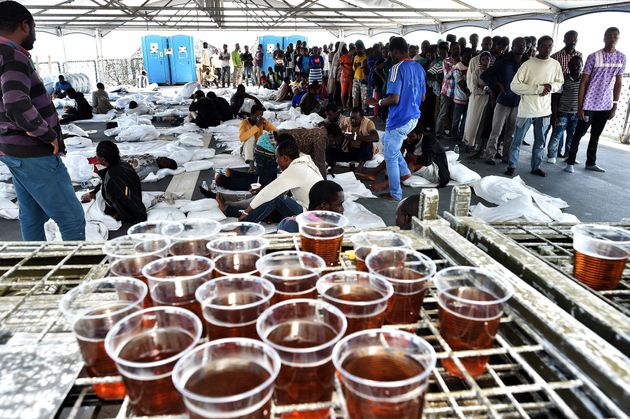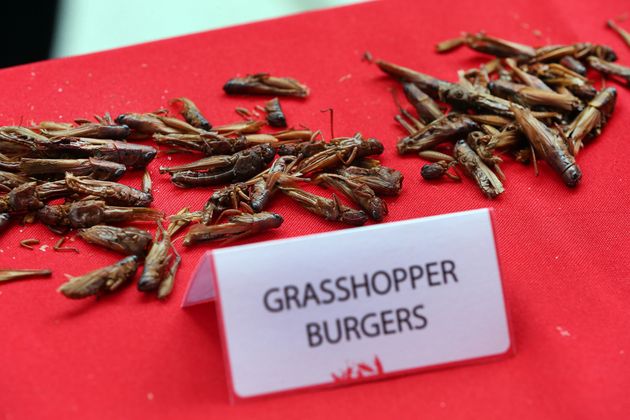Here's
What Climate Change Could Do To Your Diet
Catherine Woteki, a top food scientist, highlighted the role
that precision agriculture, genetic engineering and bugs could play in feeding
the growing human population.
Posted: 10/20/2015 04:04 PM EDT | Edited: 10/21/2015 11:30 PM EDT
Humans have been domesticating plants and animals for over 10,000 years, enabling our population to grow to over 7
billion people. Farmers around the world now face climate change
and shifts in weather patterns that pose risks to their livelihoods and
our food supplies.
To get a sense of what's happening to address the challenges, I
interviewed Dr. Catherine Woteki last week while I was in Iowa to
moderate a roundtable at the Borlaug Dialogue.
Woteki, undersecretary for the United States Department of
Agriculture's (USDA) research, education and economics mission area,
also serves as the department's chief scientist. (She alsocontributes to The
Huffington Post sometimes.)
Our
interview, lightly edited for clarity, follows.KEN HAMMOND
What are we doing right in agriculture today?
We are producing enough food that we've actually made a big dent
in the number of people who are hungry in this world. I think that's one
success that we should be celebrating at the same time we're focusing the Sustainable Development Goals that have just been adopted
globally to eliminate hunger over the next 15 years.
Is the issue getting the food to hungry people, as opposed to
producing it?
It's a
combination of the two. Right now, we are producing enough food around the
world to feed the population that we have. There are problems in distribution,
there are problems in people not having enough money to get food, if it is
available. There are also a lot of refugee crisis situations that we are
dealing with around the world that are creating more hungry people. There are
those kinds of problems that have to be solved.
 ALBERTO PIZZOLI VIA GETTY IMAGES
ALBERTO PIZZOLI VIA GETTY IMAGES
But yes,
to your question, we are producing enough food to feed the current population
-- but the population is projected to grow. From now until the mid-century, it
is projected to increase to over 9 billion people, and then to continue
growing after the mid-century.
Those
extra 2-plus billion people, over the current population, are also going to
need to be fed. Agriculture is going to have to produce fiber for their
clothing, wood for housing.
Agriculture
is being looked to to provide the chemical feedstocks to produce
pharmaceuticals, to produce chemicals that go into industrial processes and, at
the same time, produce clean water, reduce greenhouse gas emissions and adapt
to climate change. There's a huge agenda that remains to be done.
What approaches are not only promising but have been proven to do
what you describe?
Genetics
is one promising route. The kind of research that we're supporting, and many
other countries are also supporting, is looking to identify genes that are in
plants and animals that may give resistance to diseases, that can cause crop
failures or animal diseases, or are in crops that will be
drought-resistant or resistant to higher temperatures that are associated with
climate change.
 ASSOCIATED PRESS
ASSOCIATED PRESS
Then, either using traditional breeding methods or using the newer
genetic engineering technologies, [we can] produce new varieties of crops and improve the genetic
makeup of food animals so that they'll be resilient to climate change, because
they'll have within them these disease-resistant and pest-resistant traits,
that they'll need fewer chemicals and drugs to have an abundant production.
The kind
of research that we're doing on genetics gives me great hope that we'll be able
to increase agricultural production. One of the associated problems with that
is that we've got a finite amount of farmable land. As we in the States are
acutely aware right now, we've got water problems in the West.
Around
the world, at some point in time, countries are also experiencing these severe
weather events, droughts and restrictions on agriculture productions.
Some people may hear "genetics" and will instantly think
of genetically modified organisms, or GMOs. People worry about introducing modified variants of
plants or insects into ecosystems, from "golden rice" to fish. Where does the science stand
on potential risks and rewards?
I look at
genetic engineering techniques that we have right now and the ones that we have
in the pipeline, in addition to traditional plant and animal breeding, as being
a tool. I think the tool is neutral, with respect to impact. How it's used and
how it's applied it what makes the difference.
 ASSOCIATED PRESS
ASSOCIATED PRESS
I also
look at the first generation of genetically engineering crops and recognize
that the kind of work we're doing now, in supporting in our laboratories and
supporting in universities, is using techniques that are quite different and
quite evolved from the earlier techniques. A lot of the current public concern
is still focused on that first generation.
How are
we going to feed that 2.6 billion people with fewer inputs, like less
water, less pesticide, and less fertilizer? We're going to have to use what
we're learning about genetics to produce crops and livestock that are going to
have inherent in them the ability to come through droughts.
If you look at aquaculture, where we've bioengineered
fish, how do we think about the relative risk and reward of those
fish being around wild populations? I'm thinking of the salmon pens I've
kayaked past on the coast of Maine, for instance. There's immediate impact and
the long term impact of escaped fish on native species.
You're making reference to the genetically engineered salmon that has been in the
regulatory pipeline for over a decade. I know there's been a lot research that
has gone into the safety of that for people who would be eating the fish, as
well as the safety for the environment. It's an area that's not research that I
am directly involved in, and certainly at this point we are not the regulatory
agency that's the one with the direct responsibility.
I think
that the Food and Drug Administration, which does have that regulatory
responsibility, has been doing a really thorough job at looking at both food safety and environmental safety.
 ASSOCIATED PRESS
ASSOCIATED PRESS
Moving back on to land, is part of our future mix of food
going to be cricket burgers?
There are
populations around the world that do look at insects being an important food
source. There are also ways, though, that insects and insect larvae could be
raised as a food source for an animal, for example, and that we might eat the
meat from that animal. Insects and other foods that we in United States may not
think about as being food for people, for other people in the world they are.
It's very culturally determined.
 BOSTON GLOBE VIA GETTY IMAGES
BOSTON GLOBE VIA GETTY IMAGES
I've eaten my share of crabs and lobsters, and they don't look so
different. A bit bigger and tastier, perhaps.
Well, you know there is a crustacean in Australia that
they call "bugs." They do have very long legs. The name is kind of
off-putting, but…
I've also heard lobsters called bugs or the "cockroaches of the sea," too. It's not the most appetizing name, but I think
they're tasty.
How close do you think we are to growing our food in laboratories, as opposed to more
energy-intensive industrial farming techniques in use today?
So much
about our food supply depends on the public. If there will be a demand for that
type of product, I think it can be developed and delivered. I think a lot
depends on the public, just as your earlier question about insects.
 BLOOMBERG VIA GETTY IMAGES
BLOOMBERG VIA GETTY IMAGES
My suspicion is that within the next 50 years,
we'll see some kinds of protein become ultra-expensive or culturally tainted,
and others become more accessible and acceptable, whether they're plant-based, insect-based or laboratory-based.
We do
know that the consumers respond to price.
Bugs and vat-grown meat aside, I've heard so much about precision agriculturehere at the conference. Where was the
science on this 10 years ago? Where are we now? What's next?
I think
it's really interesting that precision medicine is just being talked about, but
precision agriculture has been around for a long time and is actually being
practiced. If we had the time, right now, we could go not too many miles away
down the road here from Des Moines out on one of those fields that's being
harvested and you would see the most incredible precision agriculture in
practice.
Farmers
who have planted their fields with Global Positioning Systems, managed them all
through the year with the fertilizer being delivered to those areas of the
field where it was needed and not in others. Spraying being done for pests only
in certain areas of the field, and not in others. At the harvest, they're able
to know, in a very small area of the field, what the yield is. And then,
because of all of the records they had over the season, be able to make their
plans for next year about how they're going to better manage that field.
 BRENDAN SMIALOWSKI VIA GETTY IMAGES
BRENDAN SMIALOWSKI VIA GETTY IMAGES
Precision agriculture is here, today. There are also
companies here that are selling those service to farmers. Some are even selling
crop insurance to go along with it.
There is
also a lot of work going on with unmanned vehicles — what some people call
drones - with applications for how to better scout the fields through the
course of the growing season.
We're
doing work with NASA and NOAA, using satellites, and getting much better
information from satellites about crop conditions, soil moisture, and using
remote sensing, and then providing that information back to farmers.
In a way that's actionable for them to respond in a timely way?
Exactly.
What changes are you seeing that could change the world the most
in the next 10 years? What concerns you the most?
The
changes that give me great confidence that we'll be able to increase
agricultural productivity, particularly in areas of the world where there are
food shortages now, like in sub-Saharan Africa and certain parts of Asia and
Latin America are the application of these new technologies.
Regarding
the theme we're going to be talking about — open data for agriculture — I have visited farmers in
remote areas of Africa and Asia where they have cellphones and applications
that can deliver information to them about markets in which they can bring
their crops to, about disease threats, about weather events, that can help them
better manage their farms.
 ASSOCIATED PRESS
ASSOCIATED PRESS
These are
already technologies within our grasp that are already applications that are
being delivered in developing countries. That gives me great hope. Better
seeds, higher-producing seeds, that can be delivered to smaller-holder farmers
to improve their productivity, give me great hope.
As to
your question about concerns, I think one of our greatest concerns is more
variable weather. We are experiencing here in the states, as well as around the
world, much more variable weather patterns. Farmers here in the U.S. can tell
you that their planting dates have changed, that they're planting earlier. They
can also tell you that they've had floods or tornados or rain that's occurred
too early or too late, not the usual seasonal patterns. They're experiencing
more extreme weather and changes in weather that affect their ability to
produce.
Over this
next decade and the decades to come, being able to develop varieties of crops
that are more resilient to drought, temperature and other weather events is
going to be a big challenge for us, but one that I also think there is a good
likelihood that we'll be able to deliver for the farmers.
No comments:
Post a Comment